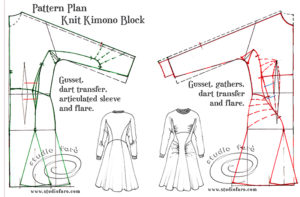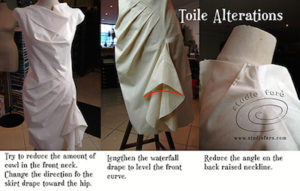The following glossary is a work in progress. It’s not a full glossary but a representation of the questions I often get asked in the classroom about pattern making and related issues. I’m very happy to receive requests to add information not yet included. I’m also open to any challenges or additions to the following information. Email me! After all, I can’t possibly know everything. 😏🙏
Jump to Section:
It’s possible that this page will grow and grow in length and detail. To make your research a little easier I have provided links in the above headings so you can click through to your favourite subject without too much scrolling.
Full disclosure: I’m neither a textile nor garment technologist. What I share here is my understanding of textiles and clothing from the perspective of an industry-based designer/pattern maker. Any links added here are for additional information and research do not indicate sponsorship or promotion.
General talking points:
Difference between fibres and fabrics: So often in conversation and sometimes in print I find confusion in the use of terms to describe fibres and fabrics. For me the most common example is the confusion between the use of the terms silk and satin to mean the same thing. Silk is a fibre and can be woven into many different fabrics, only one of them being a satin. Whereas satin is a weave and it can be woven out of many different fibres, the most common being silk, nylon or polyester.
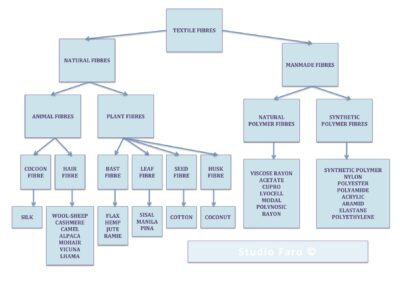
Fibres
The textile chart above is indicative only and will be subject to change as the industry develops new fibres and fabrics to suit diverse markets.
Lycra, Spandex and Elastane:
Elastane is the generic name of a latex based fibre woven and knitted into cloth to give it added stretch and excellent recovery. Lycra and Spandex are brand names for elastane fibres. In my own experience these branded fibres are often of a higher quality.
Rayon and Viscose:
Viscose, Modal, Lyocell, Tencel, Cupro, etc.
There is a lot of confusion around the fibres made using the rayon method. They are often classified as natural rather than manmade, but that is misleading. Yes they may be considered to have some organic origins as cellulosic materials are processed in the making of these fibres. But the fibre it’s self is made by a manmade process and is therefore manmade by definition.
What is often used in misleading claims about rayon is the fact that re-cycled cotton, soy and bamboo can be used in the making of many rayon fibres. And the processes involved are a long way from environmentally favourable using a lot of chemicals, energy and water. Many other types of cellulosic materials are used in the making of rayon fibres (eucalyptus wood pulp for example).
So the word rayon is related to the process of making the fibre, not a fibre in itself. And labels like viscose, tencel, modal, etc. relate to specific brands, techniques and recipes in the making of rayon fibres.
Know about Textile Fibres from Coates
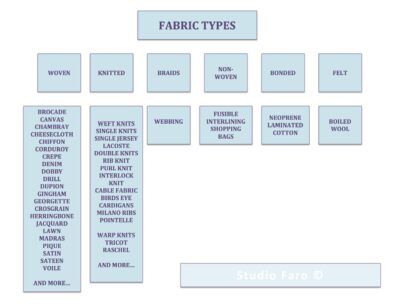
Fabrics
Fabrics are woven and knitted from different fibres for different purposes. In making clothing we can only hope to use the appropriate fabric for the desired end use. We consider the fibre, the weave or knit, and the weight of fabric in making our choices.
All fibres have there own special qualities that we consider in making our selection. In general cotton and linen are best for hot climates and seasons. Wool is best for colder climates and some performance end-use. And some manmade fibres have very special performance characteristics to make them suitable for corporate and school wear. These of course are all generalisations as fabrics have so many variables.
Woven, non-woven and knitted fabrics have vastly different characteristics.
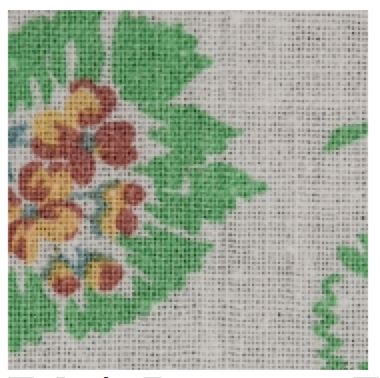
Woven Fabric
Woven fabrics are created using warp (longitudinal) and weft (latitudinal) yarns that are woven into each other in particular patterns to form a flat cloth. Woven fabrics are less stretchable due to the fact that it’s tightly woven threads.
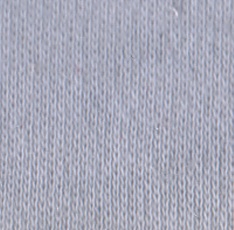
Knitted Fabric
Knitted fabric involves the looping or interlacing of a single yarn or thread. The looping permits a lot of movement in both direct that permits stretch in the fabric.
Non-woven fabrics are lighter and weaker than woven or knit fabrics making them unsuitable in durable clothing applications.
Warp Yarn: The warp yarn runs the length of the fabric.
Weft Yarn: The weft yarn runs left to right across the width of the fabric between the selvedges.
Selvedge or Selvage: The narrow, firmly woven finished edge on both long sides of woven fabric.
Types of Fabric A-Z
28 Types of Fabrics and Their Uses
A to Z of Fabrics from The Silk Society
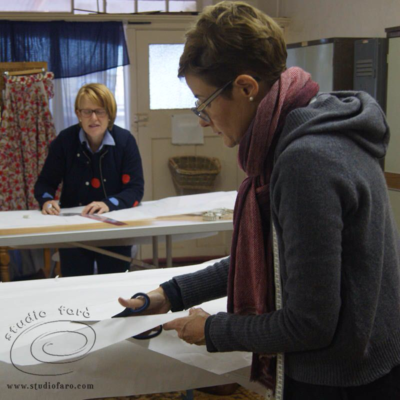
Pattern Making
Blocks and Patterns: In the creation of clothing we use both blocks and patterns. These are not the only means of making clothing, but they are the most commonly used. To begin we create blocks using scientifically established size charts that represent the market we are targeting.
These blocks are devoid of design detail and focus solely on fit and balance. They have the basic garment ease required for there final purpose and are ready to use in the making of individual patterns. They have no seam allowances as they are never to be sewn into garments as such. They are simply the building blocks we use to make designed garments.
Patterns are created to follow a new design idea generated to suit a clothing range, a client or individual need. Initially the most appropriate block is selected and the design for the new pattern is applied to the block and the final sewing pattern extracted. Seam allowances are added to suit the nature of the construction, machinery available and quality expected in the market place.
What may be confusing in some instances is that makers may refer to popular patterns as block patterns because they are the basis of many variations, used over many seasons, made to satisfy a particular market.
Balance: Garment balance is the alignment of one section of a garment to another, in harmony with the natural attitude of the figure, especially that of the back and front lengths.
Balance Marks: Notches on adjoining pattern pieces to retain the garment balance when sewn. Typical positions are at the centre back and centre front lines, armhole and sleeve head, bust, waist and hip level.
Fit Model: A fit model is used to assess the fit, styling and overall look of the new prototype. The fit model is a person selected to represent the body proportions that the apparel organisation considers ideal for its target customer and that correspond to the size chart used to make the prototype.
Garment Ease: Garment ease is an extra amount of fabric added to a pattern so the garment permits ease of movement and basic comfort.
- Negative Ease: This is present when the sewing pattern is smaller than the body measurements it is meant to cater for. It occurs most often with garments made from stretch fabrics that have a decent (3-10%) elastane content. For example swimwear and body conscious tops, skirt, trousers and dresses.

- Designer Ease: Designer ease is an extra amount of fabric added to a garment as a design and style feature.
Grading: Producing a range of patterns of different sizes from a master pattern.
- Grade Increment: The difference in measurement between two sizes on a size chart.
- Grades (Nest of ): A stack of patterns in a range of sizes which are aligned to check the grading increments. Generally used to describe plotted computer patterns.
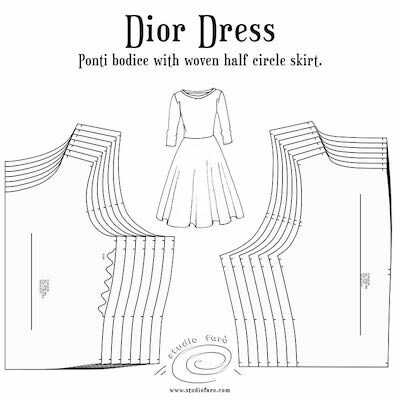
Grain Line: A straight line drawn on a sewing pattern to indicate the warp thread which is parallel to the selvedge. This grain line is used to make sure of the correct placement of a sewing pattern on fabric.
Layplan: Plan or arrangement of pattern pieces positioned, according to the marked grain line for fabric economy prior to cutting. Also required for calculating yardage and cost of fabric. Can be duplicated in small scale for reference.
Master Pattern: The final approved production pattern from which other sizes are graded. It is generally the central size in a range.
Pattern Plan or Pattern Blueprint: The planning of style features on to an outline tracing of the selected block pattern. The pattern pieces are traced from this plan and further adapted if required. The plan should not be cut out but left intact for reference.
Sample Garment: A prototype garment made to test the style, fit, size and material cost for garment production.
Seam Allowance: A seam allowance is the area between the edge of fabric and the stitching line on two (or more) pieces of material being stitched together. Seam allowances can range from 1/4″ wide (7 mm) to as much as several inches. Commercial patterns for home sewers have seam allowances ranging from 1/4″ (7mm) to 5/8″ (1.5cm).
Size Chart: A table of average body measurements derived from anthropometric studies of a representative sample of the population.
Suppression: The reduction of surplus fabric to obtain a closer fit, using darts, gathers, etc.
Toile or Muslin: An old French word meaning cloth and often applied to plain or twill weave linen fabric. Contemporary use of this work most commonly referrers to a prototype for testing the style, fit and balance of a block or garment.
Types of Pattern Making:
Draping on the Stand: Shaping or moulding fabric three dimensionally on a workroom stand or human figure to arrive at the shape of the garment.
Flat Pattern Making: The construction of a basic pattern on pattern paper from a set of instructions most often using a basic garment block.
Production Pattern: The final approved pattern used for wholesale garment production. It should have all the correct seams, hems, notches, drill holes and grain line. Made in durable card for manual grading. There is generally a pattern piece for every garment part.
Pattern Making Tools:
Drill Holes: This marks an internal position within the cut cloth, e.g. pockets, darts. The holes must be covered by stitching, therefore placed 0.5 cm to 1 cm from the stitching line.
French Curves: Used as a drawing guide for curved lines. Some incorporate parallel lines and measurements for adding seams and hems, etc.
Grading Ruler: A long 40-50cm ruler, 5cm wide, with grading increments marked in grid lines to make manual grading easier. They come in both metric and imperial increments.
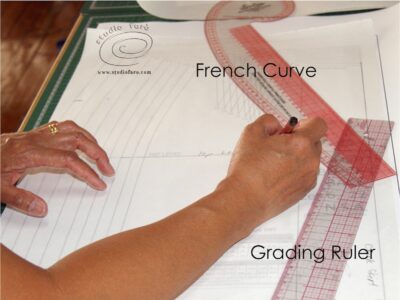
Grading Square: A large plastic set square with 90 degree and 45 degree angles. Also marked with parallel lines and measurements useful for grading and adding seams.
Mushroom Punch: A small hole punch to add drill holes to sewing patterns to indicate end of darts, pocket positions and end of sewing lines.
Notch: A mark, slit or ‘V’ shaped cut on the outer edge of a pattern or cut garment to identify adjoining seams, balance marks, CB, CF, seam allowance, hem width, areas of easing in, gathers, pleats, pocket positions, etc.
Pattern Hooks: Wire and cord pattern hanging hooks to keep individual patterns together on the clothing rail with the appropriate sample.
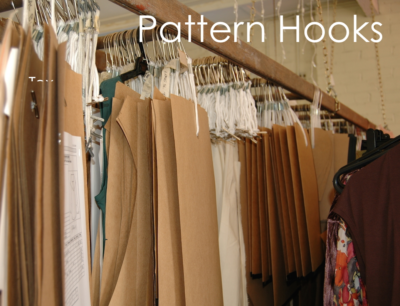
Pattern Notcher: A single purpose tool that cuts narrow notches into sewing patterns to allow the matching of pattern pieces when sewing.
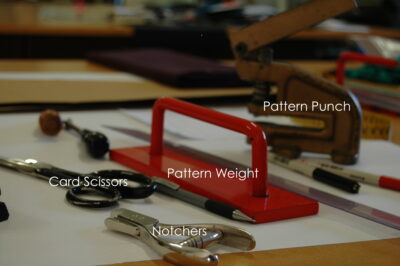
Pattern Punch: A large hole punch for patterns so they can be hung together using an pattern hook.
Pattern Weights: Metal pattern weights to hold paper, card and fabric in place. Most have a handle or hook for easy handling.
Stiletto or Awl: A sharp metal point used to transfer important pattern marking from patterns to cut fabric for the machinist. For example dart ends, pocket positions and end of tucks.
Scissors: Fabric, Paper and Card
Tracing Wheel: A needle-point wheel used to transfer a pattern shape and marking onto another piece of pattern or card.
Workroom Dummy: Moulded and padded facsimile of the human torso. They vary according to type of garment or size group, i.e. children’s, women’s, men’s and prevailing fashion. Required for checking garments or draping new styles.
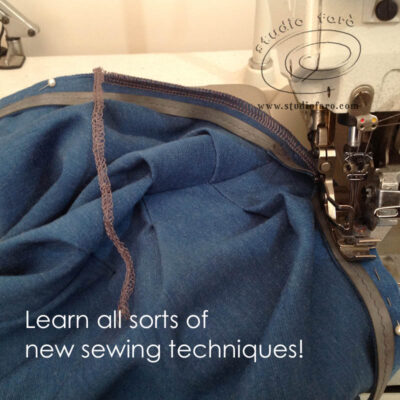
Sewing
Bagging Out: A method of stitching together garment parts with face side inwards in the form of a bag, preparatory to turning out to the face side, e.g. collars, cuffs, facings.
Bias: Fabric cut diagonally (45°) across the grain. True bias is at an angle of 45 degrees between the weft and warp. Generally bias material has a certain amount of stretch which varies according to type of fabric; this variation must always be taken into account. Bias is good for soft draping, bias binding and rouleau.
Bias Join: Bias joins are primarily used to make self binding for garments. Often used To finish the raw edge of a neckline, armhole or the inside edge of a waistband.
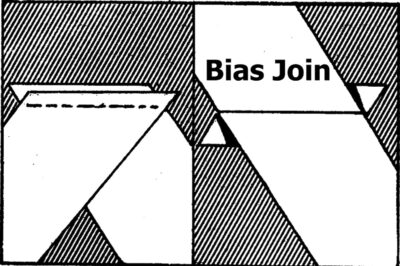
Bite of the machine: The distance from the right hand needle penetration to the left hand needle penetration (width of zig-zag stitch). The distance from the needle penetration to the edge of the fabric and blade (width of overlock stitch).
Block Fusing: The bonding of fusible interlining with a thermoplastic resin on one side, to a length of fabric, by the action of heat and pressure. Cutting garment parts after block fusing eliminates problems with shrinkage in fusing that may affect the final fit of the garment.
Dressmaking: A custom dressmaker specialises in women’s custom apparel, including day dresses, career wear, suits, evening or bridal wear, sportswear, or lingerie. A tailor makes custom menswear-style jackets and the skirts or trousers that go with them, for men or women.
Factory Machinists: As a factory machinist, you will use machines to make up garments, or parts of garments (piece work), for the clothing industry. You usually use one particular machine to sew one part of the garment, such as the collar or waistband. In smaller factories, you may make the complete garment.
Interlining (Fusible): A piece of fabric stitched or fused between the garment part and facing to reinforce, stabilise, stiffen or retain the garment shape. Typically collars, facings, some hems, waistbands, fly pieces, button fronts, etc.
Mitred Corner: Mitred corners are used to finish tailored sleeves, skirt vents and wraps. This particular finish is favoured because it reduces the bulk on the finish of the outside edge of the garment.
Overlocked Seam (To Serge): A closed seam in which all the raw edges have been enclosed within the loops of the overlock and stitch used to for the seam. I can have 3 or 4 threads, or 5 threads, which would include a safety chain stitch.
Sample Machinists: A Sample Machinist constructs sewn products following specifications and quality standards, providing a sample product that is then replicated and produced on a larger scale. They need to be creative, have an eye for detail and be able to work quickly and accurately within a team.
Seam: The joining of two or more pieces of cloth.
Seam Slippage: Fabric pulling away from the seam when it is under pressure.
Tailor: A tailor is a person who makes, repairs, or alters clothing professionally, especially suits and men’s clothing. Although the term dates to the thirteenth century, tailor took on its modern sense in the late eighteenth century, and now refers to makers of men’s and women’s suits, coats, trousers, and similar garments, usually of wool, linen, or silk.
Toile or Muslin: An old French word meaning cloth and often applied to plain or twill weave linen fabric. Contemporary use of this word refers to a prototype or muslin for testing the style, fit and balance of a block or garment pattern.
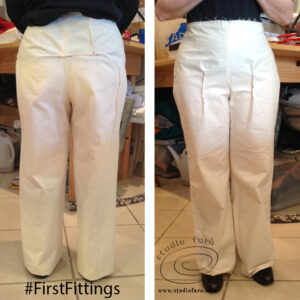
Zip Fastener: A fastening device of two flexible strips with interlocking teeth or coil, which is closed or opened by pulling along a sliding clip. They can be made out of nylon, moulded plastic or metal. Following are a few commonly used zip types:
-
-
- Closed Ended: For trousers and dress zips.
- Open Ended: For the front of casual jackets.
- Two-way Open Ended: For the front of jackets. They open from both ends making it more comfortable to sit in jackets using these zips.

Clothing
Couture: the design and manufacture of fashionable clothes to a client’s specific requirements and measurements.
- Haute Couture: Haute couture is the creation of impeccable, custom-fitted high-end fashion design that today is partially constructed by hand and often utilises other handmade, one-of-a-kind embellishments, notions and trimmings.
- RTW: Ready to Wear clothing means that, in the broadest sense, you will get a finished garment that’s been made to a standard size, ready to wear off the rail in retail outlets. Often referred to as Prêt-à-Porter. They are produced in an assembly line in textile factories around the world.
Clothing Layers: Are referred to as Lingerie, Light Clothing and Outerwear:
- Lingerie and underwear is the first layer on the skin.
- Light clothing refers to dresses, shirts, skirts and trousers that are the second layer of clothing.
- Outerwear referes to jackets and coats.
Break Point: The beginning of the break line at the top button, where the fabric folds over to form a rever.
Button Stand: An extension from the centre of the button to the finished edge of the garment. These extensions wrap over when the opening is buttoned to prevent the opening from gaping. The width of the button stand is approximately the diameter of the button, or half the diameter plus 5-10 mm. This depends upon the shape and size of the button.
Garment Ease: Is the addition we make to garment measurements for woven fabrics to create comfort and ease of fit. The amount differs according to the fabric and the garment type. The following chart is a guide to the amount of garment ease required for different fits and different garments in woven, non-stretch fabrics.

- Negative Garment Ease: Applies to garment blocks and patterns that are cut for stretch fabrics to make body conscious designs. The actual measurement of the blocks and patterns is less than the body measurement.
Godet: A segment of a circle, with the radius stitched into a seam or slit, to give extra fullness at the lower edge.
Gore: A shaped panel of a garment which increases in width at the hem or lower edge. Most commonly used in reference to shirt panels, e.g. a six gore skirt contains six panels.
Gusset: In sewing, a gusset is a triangular or square piece of fabric inserted into a seam to add breadth or reduce stress from tight-fitting clothing. Gussets were used at the shoulders, underarms, and hems of traditional shirts and chemises made of rectangular lengths of linen to shape the garments to the body.
Jetted Pocket: Tailored pocket made of two narrow (1/4”) strips of cloth as the opening with the pocket bag hidden inside the garment.
Permanent Pleating: To produce durable pleats by the application of heat, moisture and pressure. The fabric must contain sufficient synthetic fibres or applied chemical agents to enable it to set under controlled conditions. Most typically applied to polyester rich fabrics in contemporary production (min. 45% polyester to achieve desired effect).
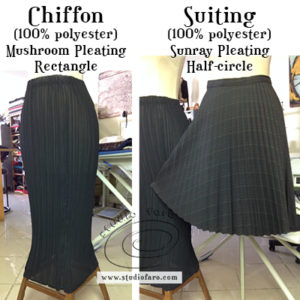
Placket: Narrow trim that finishes the edge of an opening. In particular the sleeve cuff opening on a shirt or in a neckline.
Raglan Sleeve: A part of the bodice is attached to the top of the sleeve head above the mid armhole balance marks. The underarm area is similar to a set-in sleeve. The cut of this sleeve was originally used for an overcoat made for Lord Raglan.
Rever or Lapel: The part of the front neck opening which folds outward from the neck line to the top button.
Sunray Pleat: A series of spaced, radiating, alternating creases creating a raised and recessed pattern of pleats. Much like the folds of a ladies fan.
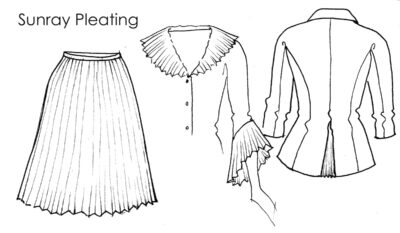
Welt Pocket: Tailored pocket that uses a single band of fabric to finish to top edge of the pocket with the pocket bag inside the garment. Width is optional. Also found on casual wear.
Vent: A short opening in the hem or a garment.
Yoke: Part of a garment, which is fitted over the shoulders or between the waist and hip, from which the rest of the garment hangs. The yoke can be cut double as reinforcement.





